Rip it up and start again: RHS Wisley's daring reinvention of one of its most famous plantings
Piet Oudolf, father of the New Perennial Movement, has dug up his famous double borders at the Royal Horticultural Society’s garden at Wisley in Surrey and transformed them. John Hoyland takes a look, with photographs by Clive Nichols.
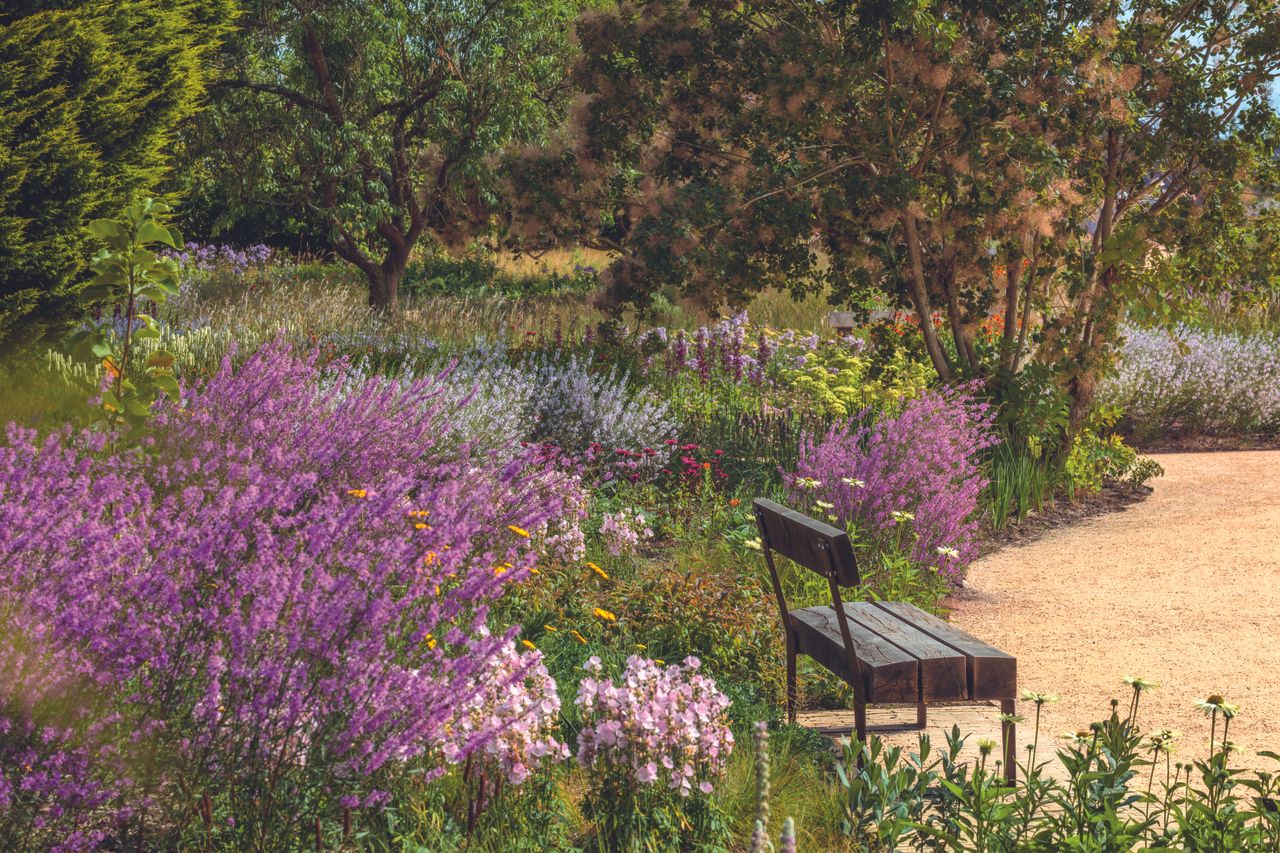
Twenty years ago, at its garden in Wisley, Surrey, the Royal Horticultural Society (RHS) unveiled a monumental double border covering two acres, created by the Dutch garden designer Piet Oudolf. Recently, the borders had started to look tired and, during the intervening decades, Mr Oudolf, a leading exponent in what had become known as the New Perennial Movement, had developed his ideas and his practice.
Boldly, he and the RHS decided to redesign and replant the whole area at from scratch. The result, which opened a few months ago, is a glorious and uplifting celebration of the art of the designer and of the skills of the RHS Wisley gardeners.
How to get RHS Wisley-style borders in your garden
- Don’t skimp on the number of plants. Blocks of plants should be as large as your garden will allow. To make an impact, plant in groups of at least 25 plants
- Ignore old advice about tall plants at the back of the border and shorter ones at the front. Delicate grasses, such as Molinia caerulea ‘Transparent’, planted at the edge of a path, create a gauzy curtain through which to view the border
- You don’t need to start off with large plants to make an impact the same year. The majority of the plants here were grown in 3½in or 7in pots. The borders were planted this spring and were already exuberant by the summer
- Some plants take time to establish, but, even before they reach maturity, they are still welcome guests that contribute to the party. Stipa gigantea will need at least a season before it sends up tall golden stems, but its tufts of evergreen foliage are an attractive background to other plants. Baptisia will take even longer to mature, but the young glaucous shoots make a handsome partner to many plants
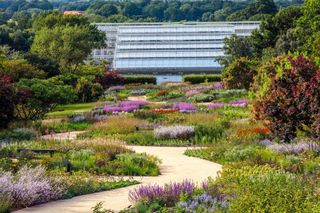
The original borders were flanked by a wide grassy path — described by one pundit as a light-aircraft landing strip — with a viewing mound as a focal point at the top of an incline, so that visitors were propelled toward it and past the borders with barely a glimpse at what plants they contained or how they were constructed. This was frustrating for the designer and for the RHS. The organisation’s remit to educate gardeners and its desire to showcase the planting ideas of Europe’s most important garden designer provided the motivation — and the courage — to dig up the borders and start afresh.
Mr Oudolf’s first priority was to slow visitors down, so they had time to look at the plants and study his techniques, but, above all, appreciate the beauty of the groups of plants, the way they enhance each other, their movement and their changes through the season. To achieve this, he introduced a path that meanders to the top of the hill, with secondary paths looping around it. The layout allows one to get close to the plants and also gives a sense of being enclosed within the planting scheme. From people’s reactions, it is clear that the new design is popular.
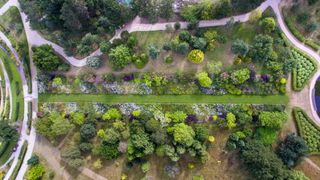
The garden showcases the two distinct planting styles Mr Oudolf has honed over his long career. In both, he prioritises the structural qualities of a plant over transitory characteristics of colour and flowers. How the skeleton of a plant appears in midwinter is as important as how it performs at the height of the season. His most well-known technique is to plant large blocks of perennials and grasses, usually repeated, often with the edges of each group gently merging into the next.
Mr Oudolf’s priority may not be colour, but, in the new borders, there are some eye-catching juxtapositions: a group of soft-pink Lythrum virgatum ‘Happiness’ is enlivened by a cluster of dark-purple Lobelia x speciosa ‘Hadspen Purple’, as, elsewhere, swathes of flaming red heleniums are partnered with the acid-yellow flat heads of an achillea.
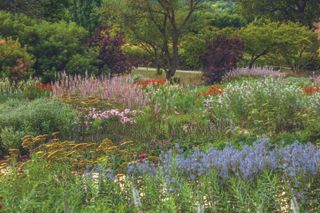
These block plantings evoke the bold colours and strong brush strokes of Fauvist painters, such as Derain and Matisse, whereas Mr Oudolf’s other technique, which he calls matrix planting, is often compared to the pointillism of Seurat and Pissaro. Matrix planting draws inspiration from the way plants grow in the wild, where a few species dominate and specimens of other species meld into them or are dotted through the main group of plants.
Sign up for the Country Life Newsletter
Exquisite houses, the beauty of Nature, and how to get the most from your life, straight to your inbox.
Four border combinations to borrow from the work done at RHS Wisley
- Velvety-grey carpets of Stachys byzantina are a perfect partner for a pastel-blue Salvia nemorosa, to which Mr Oudolf adds the startling orange flowers of several Asclepias tuberosa
- The dark-green leaves of Eragrostis spectabilis turn red and gold in autumn and carry a cloud of deep-pink flowers. Growing through them are specimens of spiky sea holly, Eryngium bourgatii, softened by the occasional plant of Baltic parsley, Cenolophium denudatum
- In the borders, the white spires and dark-green foliage of Lysimachia ephemerum weave their way between groups of fiery heleniums and mounds of creamy flowers of Hylotelephium (formerly Sedum) ‘Sunkissed’
- The upright foliage of Allium lusitanicum, a dwarf onion less than 1ft tall, is planted in a checkerboard pattern with the flat rosette leaves of Limonium platyphyllum. In summer, a froth of lavender flowers from the limonium will float above the plants. Joining them intermittently are pale-pink spires of Sidalcea ‘Little Princess’
At Wisley, a carpet of the sweet-smelling grass Sporobolus heterolepis is punctuated by the airy stems and pale-mauve flowers of Scabiosa columbaria and by an occasional Cenolophium denudatum, a relative of cow parsley. The glaucous leaves of another grass, Schizachyrium scoparium ‘Ha Ha Tonka’, a favourite of Mr Oudolf’s, grows through low mats of Geranium renardii, together with lavender Phlox paniculata ‘Blue Paradise’.
The new planting scheme holds few shrubs. Old, oft-pollarded specimens of Cotinus coggygria, remnants of the former borders, bring a muscular presence to the airiness of the planting. A few young Magnolia denudata have been added, but it will be several years before these begin to make an impression.
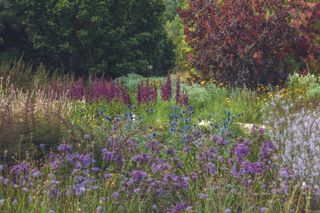
The borders are a celebration of the year-round value of herbaceous perennials. The few evergreen plants include cultivars of Deschampsia cespitosa and several geraniums with semi-evergreen foliage, so, in winter, it is the lingering seedheads and dead stems of perennials and grasses that provide visual interest, standing as nostalgic reminders of their summer heyday. As importantly, they also offer food and habitat for a wide range of invertebrates and small mammals.
Leaving the plants standing through the winter is a daring move; some traditionalists will frown, but many more gardeners will begin to see the value of perennial plants even as they die down. The new beds are already a magnificent addition to the Wisley garden and, as the plants develop and the groupings knit together, they will become even more breathtaking.
Visit www.rhs.org.uk/Wisley
-
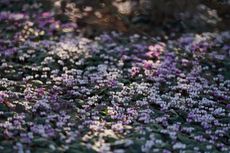 Isabel Bannerman: The year’s first and most abundantly cheery, uplifting and undemanding of winter flowers
Isabel Bannerman: The year’s first and most abundantly cheery, uplifting and undemanding of winter flowersCyclamen coum is one of the plants that lights up our gardens at this time of year.
By Isabel Bannerman Published
-
 Dawn Chorus: Gangster badgers, at home with Sienna Miller, and a fresh slap in the face for first-time buyers
Dawn Chorus: Gangster badgers, at home with Sienna Miller, and a fresh slap in the face for first-time buyersFriday's Dawn Chorus looks at a badger gan
By Toby Keel Published